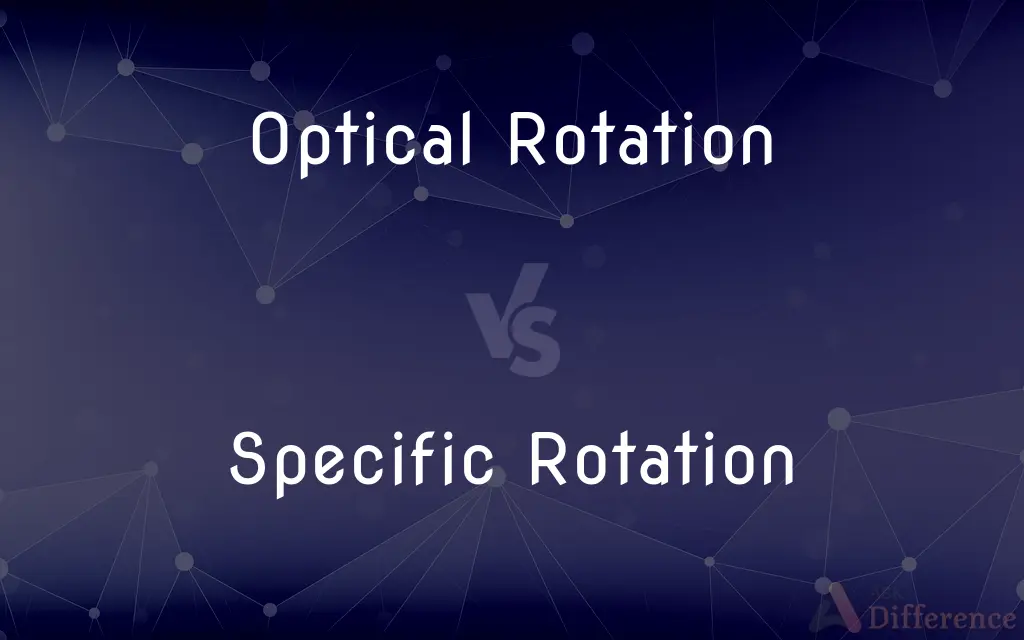Optical Rotation vs. Specific Rotation — What's the Difference?
By Tayyaba Rehman — Published on November 11, 2023
Optical Rotation refers to a compound's ability to rotate plane-polarized light, whereas Specific Rotation quantifies this by considering concentration and path length.

Difference Between Optical Rotation and Specific Rotation
Table of Contents
ADVERTISEMENT
Key Differences
The concept of Optical Rotation and Specific Rotation emanates from the study of chiral molecules and their interaction with plane-polarized light. Optical Rotation implies a molecule's inherent ability to rotate the plane of polarized light, a characteristic phenomenon exhibited by optically active substances. Specific Rotation, in comparison, is the normalized measurement of this rotation, factoring in the length of the light path and the concentration of the chiral molecule, thereby providing a standardized measure.
When observing Optical Rotation, one perceives the degree to which a substance can rotate the plane of light without considering the depth of the solution the light passes through or the concentration of the optically active substance. On the other side, Specific Rotation formalizes this observation, applying a mathematical framework that incorporates both concentration and path length, yielding a value that can be compared across different samples and conditions.
In practical scenarios, Optical Rotation becomes a crucial qualitative parameter that underscores a substance's chiral nature and the direction of rotation, whether it is dextrorotatory (clockwise) or levorotatory (counterclockwise). Specific Rotation elevates this understanding by providing a quantifiable and reproducible measure, offering insights that facilitate comparisons and comprehensive analyses, often vital in research and quality control in chemical contexts.
Optical Rotation is indicative of a molecule's stereochemical configuration, discerning whether it has the capability to rotate plane-polarized light. Specific Rotation, however, extends beyond mere capability, venturing into a quantifiable realm that allows scientists to communicate and compare the extent of optical rotation in a standardized manner, independent of experimental setup.
Elaborating further, Optical Rotation is inherently dependent on physical conditions like temperature and wavelength of light used, presenting a value that might lack universal applicability. Conversely, Specific Rotation, by its definition, is an intrinsic property of the substance, unaffected by variations in concentration or path length, and thus, allows a standardized characterization of optical activity across diverse scenarios.
ADVERTISEMENT
Comparison Chart
Definition
Rotation of plane-polarized light
Normalized measure of optical rotation
Dependency
Dependent on concentration and path length
Independent of concentration and path length
Quantitative Aspect
Qualitative
Quantitative
Units
Degrees
Degrees per decimeter per gram per milliliter
Standardization
Not standardized
Standardized across conditions
Compare with Definitions
Optical Rotation
Optical Rotation is measured in degrees.
The Optical Rotation of the solution was measured to be -45°.
Specific Rotation
Specific Rotation standardizes optical rotation measurements.
The Specific Rotation of menthol is -49.0°.
Optical Rotation
Optical Rotation indicates chirality in molecules.
The Optical Rotation verified the molecule's chiral nature.
Specific Rotation
Specific Rotation is an intrinsic property of a substance.
Specific Rotation is a valuable parameter in identifying chiral compounds.
Optical Rotation
Optical Rotation can be clockwise or anticlockwise.
The enantiomer caused an anticlockwise Optical Rotation.
Specific Rotation
Specific Rotation is concentration and path length independent.
Specific Rotation facilitates consistent comparison between samples.
Optical Rotation
Optical Rotation is the twisting of plane-polarized light.
The sugar solution displayed an Optical Rotation of +30°.
Specific Rotation
Specific Rotation uses a mathematical formula for calculation.
The Specific Rotation was calculated using the observed rotation, path length, and concentration.
Optical Rotation
Optical Rotation is influenced by concentration and path length.
Altering the solution's concentration changed its Optical Rotation.
Specific Rotation
Specific Rotation is measured at a defined wavelength and temperature.
The Specific Rotation was recorded at a 589 nm wavelength.
Common Curiosities
How is Specific Rotation different from Optical Rotation?
Specific Rotation standardizes Optical Rotation for concentration and path length.
Can Optical Rotation be negative?
Yes, a negative Optical Rotation indicates counterclockwise rotation.
How does the path length affect Optical Rotation?
Increasing path length generally increases the observed Optical Rotation.
Is Optical Rotation intrinsic to a compound?
Yes, but its observed value can change with concentration and path length.
What does Optical Rotation signify?
Optical Rotation signifies a substance’s ability to rotate plane-polarized light.
What does a positive Specific Rotation indicate?
A positive Specific Rotation indicates clockwise rotation of plane-polarized light.
Does Specific Rotation provide qualitative or quantitative data?
Specific Rotation provides quantitative data about a substance’s optical activity.
Is Specific Rotation always measured at the same wavelength?
It's typically measured at 589 nm but can be defined at other wavelengths.
Can Specific Rotation change with temperature?
Yes, Specific Rotation can vary with temperature and is usually specified at a standard temperature.
Can Optical Rotation be used to identify enantiomers?
Yes, enantiomers will rotate light in opposite directions.
What is the unit of Optical Rotation?
Degrees (°) represent the unit of Optical Rotation.
Is Optical Rotation affected by the light’s wavelength?
Yes, Optical Rotation can vary with different wavelengths of light.
Why is Specific Rotation useful in scientific studies?
It provides a standardized measure of optical activity, aiding comparisons and analyses.
How is Specific Rotation mathematically defined?
It is defined as the optical rotation divided by the path length and concentration.
Is Optical Rotation applicable to all compounds?
Only to chiral compounds, as they can rotate plane-polarized light.
Share Your Discovery

Previous Comparison
Cheque vs. Demand Draft
Next Comparison
Mannitol vs. D-MannitolAuthor Spotlight
Written by
Tayyaba RehmanTayyaba Rehman is a distinguished writer, currently serving as a primary contributor to askdifference.com. As a researcher in semantics and etymology, Tayyaba's passion for the complexity of languages and their distinctions has found a perfect home on the platform. Tayyaba delves into the intricacies of language, distinguishing between commonly confused words and phrases, thereby providing clarity for readers worldwide.












































